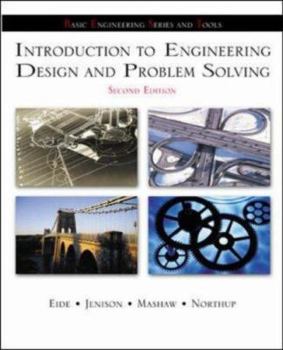Introduction to Engineering Design & Problem Solving
Divided into two major sections. The first section of this book is an introduction to engineering, beginning with a description and breakdown of the engineering profession. The second section is... This description may be from another edition of this product.
Format:Paperback
Language:English
ISBN:0072402210
ISBN13:9780072402216
Release Date:January 2001
Publisher:McGraw-Hill Science/Engineering/Math
Length:230 Pages
Weight:0.85 lbs.
Dimensions:0.4" x 7.3" x 9.1"
Customer Reviews
2 ratings
Solid Foundation for Engineers and Designers
Published by Thriftbooks.com User , 19 years ago
I actually ended up reading this book after getting my master's degree in aerospace engineering, and even after a few years of work in industry. This was because my first crack at doing real aircraft structural design work put me completely in over my head, and this book was the first step of getting a handle on everything. In retrospect I'm completely aghast that in six years and two degrees of engineering schooling, nothing like this was taught at my particular school (which shall go un-named for it's own sake), yet it is required for the freshman year at U of Iowa. Engineers are tasked with developing systems that produce value in a nutshell. The way you configure and define that system, iteratively dealing with the bigger parts first and sequentially working your way down to defining the smallest details last, is engineering design. This book explains the whole philosophy behind design, and how to do it. It's essentially a decision-making process, that can actually carry over into practically anything you do in life so even non-technical people could probably benefit from this book. Politicians, policy wonks / analysts, and people who debate politics in particular could have much more meaningful and productive discussions if they actually employed a design framework. (Maybe they do, but I haven't seen much evidence of it . . .) This book lays out a ten step process of design that is iterative. Meaning you can always (and actually will have to do so many, many times) go back and repeat steps. Although these ten steps are not written in stone, and I would highly recommend any engineer / designer to develop their own steps, they are an excellent guide to improving the quality and reducing the difficulty of design work. It ends up schools (at least mine) only really teach analysis, which was just one of the ten steps. This is one of the most laborious, most important, and, critically, easily taught so that's probably why schools concentrate on it. But they'll do their students a huge dis-service if they don't even tell the students about the other steps! Once you read the steps they sound pretty obvious / intuitive, but this doesn't mean people will know about them and apply them unless they're introduced to them first. I would also recommend that any engineer get a good book on systems engineering if they want to understand design in a more comprehensive sense. Blanchard in particular has some good books. My school taught systems engineering as an elective that you were practically dissuaded from taking, and only offered to grad students. Instead it should be a required course that's offered before students take their capstone senior year design courses.
Teacher & Engineer
Published by Thriftbooks.com User , 20 years ago
It is a must read for a freshment engineering student. If you can get a copy, it will be a good reference for your entire engineering study.





